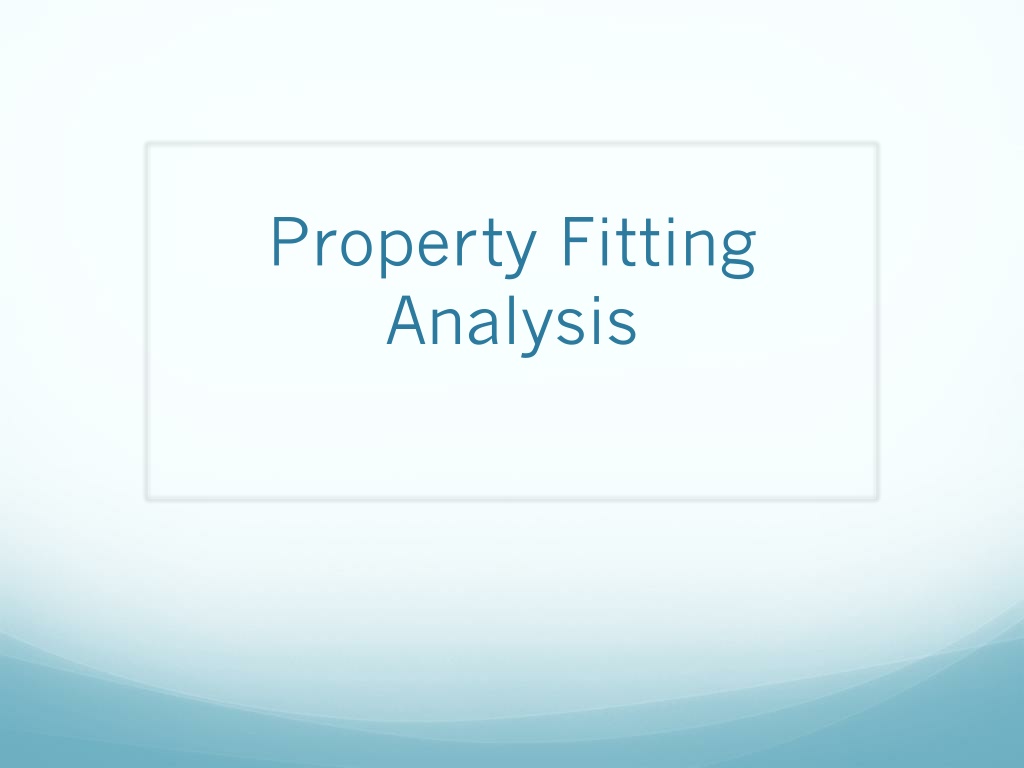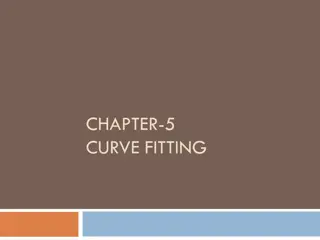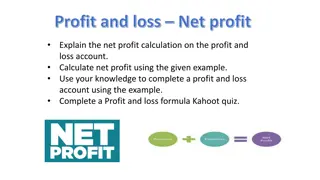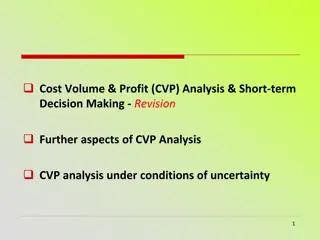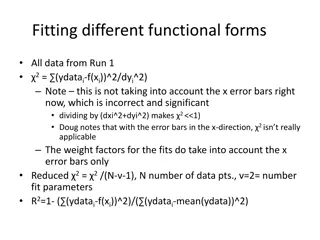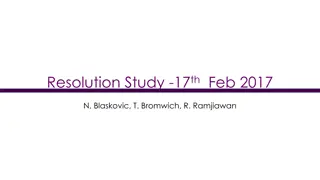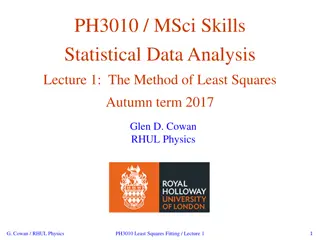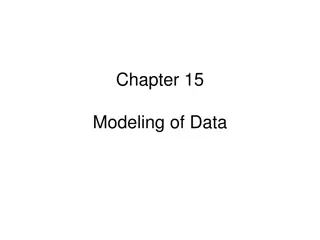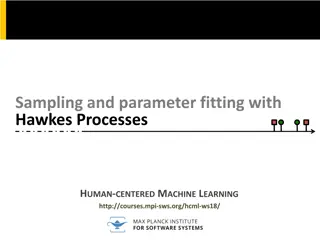Understanding Property Fitting Analysis Using PROFIT Method
Property Fitting Analysis, with the use of the PROFIT method, evaluates the correlation between item attributes and their locations in a multidimensional space. It helps test theories on how people perceive similarities among items in a cultural domain by analyzing MDS graphics, clusters, and dimensions. The analysis is exemplified in the context of dog breeds using the Anthropac Methods Guide, revealing insights into how individuals perceive and categorize similarities based on specific attributes.
Download Presentation

Please find below an Image/Link to download the presentation.
The content on the website is provided AS IS for your information and personal use only. It may not be sold, licensed, or shared on other websites without obtaining consent from the author. Download presentation by click this link. If you encounter any issues during the download, it is possible that the publisher has removed the file from their server.
E N D
Presentation Transcript
Property Fitting Analysis
PROperty FITting PROFIT analysis evaluates the correspondence between one or more item attributes and the location of items in a multidimensional space. We use PROFIT to test our ideas about what people were thinking when they made judgments about similarities among items in a cultural domain.
When we analyze an MDS graphic, we look for chunks and arrays, or clusters and dimensions. Cluster analysis is for testing ideas about the chunks. PROFIT is for testing ideas about the dimensions.
Dog breeds The next 3 slides, from the Anthropac Methods Guide, show the MDS for similarities in a set of dog breeds. The first graphic shows the plain MDS. The second shows the PROFIT lines for two dimensions. The third shows how to interpret those lines.
Borgatti. 1996. ANTHROPAC 4.0 Methods Guide. Natick, MA: Analytic Technologies p.34
Borgatti. 1996. ANTHROPAC 4.0 Methods Guide. Natick, MA: Analytic Technologies p.35
Borgatti. 1996. ANTHROPAC 4.0 Methods Guide. Natick, MA: Analytic Technologies p.37
What PROFIT does The first slide is a raw MDS of perceived similarities among dog breeds such as might result from a set of pile sorts. Looking at the MDS graphic, we see Chihuahua and Pekinese way over on the upper left and Wolfhound and St. Bernard way over on the lower right.
The hypothesis is that, when people were sorting the breeds, they were thinking: Well, this is a big dog, so it goes here with the other big dogs. These dogs are similar because of their size.
Human beings look for patterns We need to test our hypothesis because it s very easy to read patterns into anything MDS graphics, cloud formations, piles of rocks, clusters of stars
We need to test two things: the precise extent to which the breeds of dogs are, in fact, larger as we go from upper left to lower right on the MDS graph. the precise direction of the array, if in fact, our guess about the array is correct. Is the dimension from 11 to 5 o clock? 11:20 to 5:10? 10:30 to 5:45?
To make these measurements, we take the coordinates for each item on the MDS map and model its relation to the attribute of each item we ve named in our hypothesis. Here, we ve named breed size, so we run a multiple regression using the coordinates for each breed in the MDS map as the independent variables and some estimate of the breed size as the dependent variable.
In Borgattis example, there is etic information: the actual average weight and height for each breed. If you ask people to sort brands of beer, you might hypothesize that price is one of the attributes driving people s judgments about what goes with what. You can look up price, too.
For emic data, we measure the attribute by asking people to rate or rank the items in a domain. But even when you have etic data for an attribute, you ll want to test the extent to which people s judgments follow those data.
The strongest test is with a new sample of people that is, people who did not produce the similarity data. If a second, nonrandom sample of people confirms your hypothesis, this is strong evidence for widely shared understanding of the key attributes of a domain.
The PROFIT program in Anthropac and UCINET runs a regression on one or more attributes. For the set of dogs, Borgatti tested perceived size and perceived ferocity.
Borgatti. 1996. ANTHROPAC 4.0 Methods Guide. Natick, MA: Analytic Technologies p.37
The output from the Anthropac routine gives you an r- squared statistic, which tells you whether the map coordinates predict the value of the attribute.
We are looking for strong outcomes here at least 0.7 for large domains at least 0.8 for domains with < 20 items.
Drawing the lines on the map Anthropac calculates the direction for each regression line so that you can draw the lines on the MDS map. Draw a line through the centroid of the graph to the spot indicated on the map. Indicate the direction of the line you draw with an arrowhead.
Draw a perpendicular line from each item to each of the attribute direction lines. Observe where the perpendicular intersects the dimension line and how far along that intersect is from the center.
Borgatti. 1996. ANTHROPAC 4.0 Methods Guide. Natick, MA: Analytic Technologies p.37
Susan Weller elicited disease names from urban women in Antigua, Guatemala and Huntington Beach, California. She selected the top 27 illness names in Spanish and the top 29 in English. She collected pile sort data from 24 women at each site.
Then each woman rank ordered the illness terms on four attributes: 1) most to least contagious 2) most to least serious 3) most common in children to most common in adults 4) those needing the hottest remedy or medicine to those needing the coldest (in Guatemala only)
See Figures 1-7 in Wellers article on the course web site. Weller, Susan C. (1984). Cross-Cultural Concepts of Illness: Variation and Validation. American Anthropologist 86(2): 341-351.
PROFIT results from Weller Note that for the first three plots, all vectors are within an arc of 60 degrees, indicating high consensus. Note the final figure: the hot-cold analysis may be visible in narratives, but not in judgments of similarity in the Guatemala sample.
Running PROFIT in Anthropac and UCINET The map coordinates file is the file that contains the coordinates for the MDS graph produced by the MDS program. In the window for attributes, type in the name of the file that has the attribute(s) you ve measured.
Note that you can have more than one attribute in a single attribute file. Use the DATA, MODIFY, MERGE routine for this. The average rating or ranking for each item will be in row 1 of the univariate statistics output.
Finally, note that you can run the MDS in up to 9 dimensions when you re preparing the coordinates file for PROFIT analysis.
